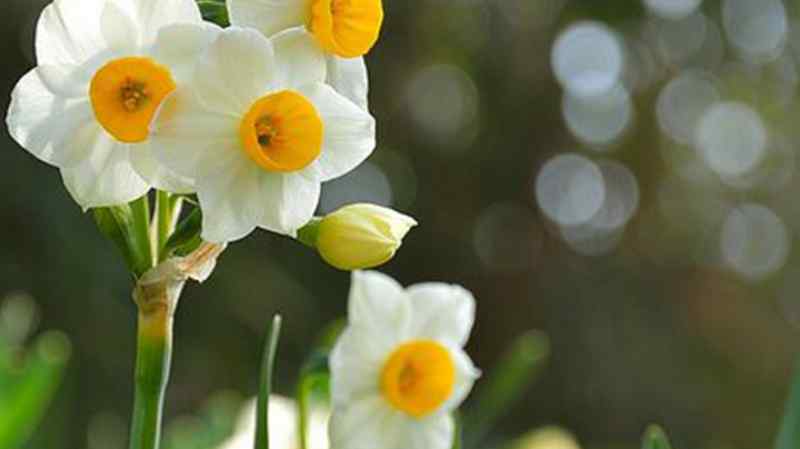While tulips have taken center-stage in Kashmir, it is the Daffodil that announces the arrival of spring for the locals. A common sight in Kashmir’s graveyards, Mazaar-posh, or Yemberzal is not only part of local literature, but symbolises love, longing and resurrection.
Surrounded by a number of myths, the Daffodil Narcissus Poeticus, knows as Nargis in the sub-continent, has traditional and cultural significance for the people in Kashmir. Known locally as Yemberzal, the white petalled beauty marks the end of the harshest period of winters.
Standing proud, wearing a majestic charm, this legendary flower fills the surroundings with sensuous aroma. The flower is among the first to bloom in early spring, announcing the departure of winter, and the onset of bahaar.
First bloom
Though the valley of Kashmir is a home to rich flora and fauna, flowers like Nargis bear a special significance for the people.
Even as the flower can be spotted growing wildly in the valley, there are some peculiar places, where the they grow in abundance. The graveyard is a one such place, where the symbolic yemberzal can be seen blooming as early as February, thus earning an epithet ‘Mazar Posh’.
Daffodils find a mention in writings dating back as early as 371– 287 BC.
“By ending February, they are the first flowers to sprout in this graveyard,” says septuagenarian Muhammad Ismail Sofi, walking towards his family graveyard in Malkhah in the outskirts of Srinagar.
“Since people see them bloom mostly in these soils, which are the eternal resting places of our dear ones, the sight of a flower outrightly flashes memories associated with the departed ones,” Sofi adds, while turning nostalgic at the mention of the flower.
Symbolic legacy
The Narcissus acquires its name from the Greek legend of a young and handsome hunter named Narcissus. It is said that as a result of his extreme vanity, he fell in love with his own reflection in a pond.
One version of the story states that Narcissus then drowned in the pond while gazing at his reflection, and it is from here that the Narcissus Daffodil bloomed.
The flower might be seen as a sign of gloom and vanity in the West, but in China the same flower is seen as a symbol of wealth and good fortune.
Kashmiris are also fascinated with this flower where it is considered as a symbol of love, and resurrection after the storm.
For Rayees Ahmad, a teacher by profession, the flower is a message of love, bonding and life.
“There are many things associated with yemberzal. Its growth at graveyards in particular, can be symbolized with love, and the bonding that we have with our dear ones who have departed from this mortal world,” he says.
Romance with literature
Short lived, unseen and unknown to many, Nargis has fascinated poets since ages. The flower has been widely mention in the imagery created by poets and artists in Kashmir and around the world.
If William Wordsworth from the west saw ten thousand daffodils at a glance, dancing along the bay in his popular poem Daffodil, Neda Nath Nadem, a renowned Kashmiri poet pens down a revolutionary piece, whose lines became a part of movie songs too.
Yemberzali aavij zaavij thuff dith,
Tsolmut chhu traet toofaano.
Bomburuss Yemberzal beyee samkhaavon,
Nerunn prein armaano,
Toofaan shaitaan neri zung fatrith,
Saavon munz madaano.
O delicate Narcissus!
You have endured a lot of suffering.
We shall make the Narcissus meet her love,
They shall fulfil their desires,
This satanic hurricane, shall depart shortly,
And die down in the open fields.
In his popular poem Yemberzal, poet Ghulam Ahmed Mehjoor says,
He placed me in a Predicament!
Bewildered, what can a Yemberzal say,
Like the spring, the morning breeze, and the dew.
A popular Kashmiri folk song, derived from the first ever Kashmiri opera performed – Bombur ta Yemberzal, is illustrative of the love story of the Narcissus (Yemberzal) and the Bumble Bee (Bombur), and revisits the central importance of the flower to Kashmiri culture.
Poet of the east, Allama Iqbal also mentions the flower in a lamentation:
Hazaaron saal nargis apni benoori pe rotee hai,
Badee mushkil se hotaa hai chaman me deedawar paidaa.
Aligarh Muslim University has also used the flower in its tarana:
Ye meraa chaman hai meraa chaman,
Mein apne chaman kaa bulbul huun,
Sarshaar-e-nigaah-e-nargis huun,
Paa-bastaa-e-gesuu-sumbul huun.
“A popular dirge, Kashmiri Marsiya, mourning the tragedy of Karbala is also titled as Nargis,” says Marsiya reciter and an Urdu lecturer, Zakir Ali Mohammad Qasmi, while deliberating on the importance of the flower in local art and literature.
Like the literary works, the flower is once again blooming to enthral the surroundings in Kashmir. And while tulips have today taken center-stage, it is the yemberzal which has announced the bahaar.
Free Press Kashmir is now on Telegram. Click here to Join.
FPK Android App for 2G. Click here to Download.










